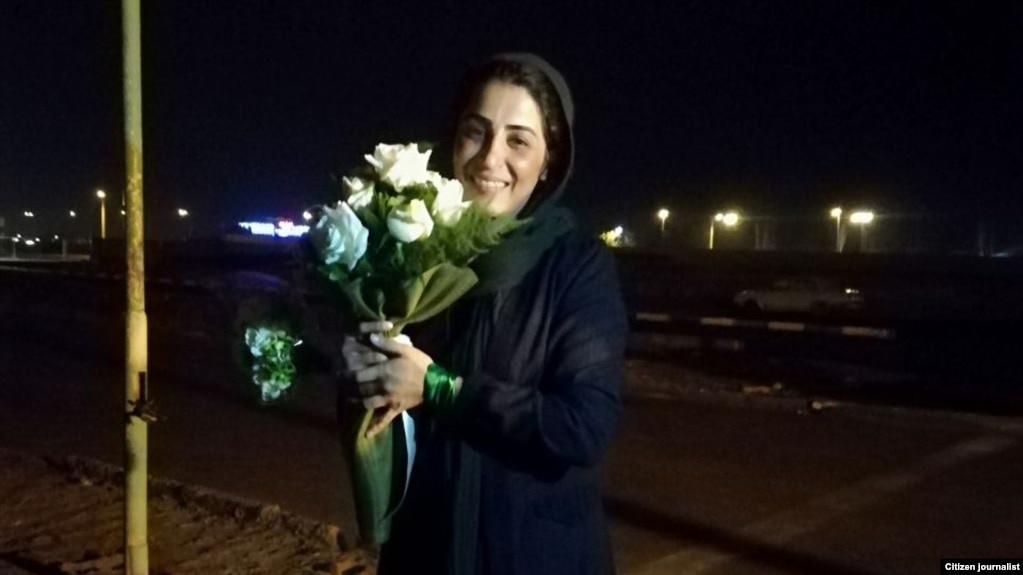Radiofarda – In an exclusive interview with Radio Farda, the woman renowned as the second “Daughter of Enghelab (Revolution) Street” insists that despite her conviction for publicly removing her headscarf, she remains staunchly against compulsory hijab.

Tasnim news agency, close to the Islamic Revolution Guards Corps (IRGC), quoted prosecutor Abbas Jafari Dolatabadi on March 7 as saying she had attempted to “encourage corruption through the removal of the hijab in public.”
Dolatabadi did not identify the woman but announced she had been sentenced to 24 months in prison and three months without parole.
Her attorney, Nasrin Sotoudeh, has identified her as Narges Hosseini.
“We are going to appeal the verdict,” Sotoudeh confirmed.
Hosseini was the second woman to stand on an electricity box on crowded Revolution Street in the heart of Tehran and remove her headscarf, waving it in the air as a flag of victory.
Hosseini was arrested on the spot and spent 20 days behind bars before being released on bail of 600 million rials (roughly $16,000).
Speaking with Radio Farda’s Vahid Pourostad, Hosseini confirmed that she had been sentenced to 24 months imprisonment.
Based on the verdict, 21 months of her prison term will be suspended.
“Even though I have been convicted, I believe more than ever that the compulsory hijab law in Iran should be resisted,” she said.
Hosseini said she didn’t expect such a tough sentence.
“I had prepared myself for any conviction before removing my headscarf, but I did not expect to be condemned to prison and paying a huge fine. I was shocked by the verdict,” she said.
She said she was amazed by the comments of the judge, who said, “Yes, it is accepted that hijab in Iran is mandatory and compulsory, but it is based on the law and one should obey the law; meaning that you should legally put a scarf, even a light and thin muslin, on your head.”
Hosseini reiterated she felt it was her duty to publicly protest compulsory hijab.
The women who protested compulsory hijab by removing their headscarves in Iran have been branded the “Girls of Revolution Street” on social media.
In the past, women arrested for appearing in public without what is considered proper covering were quickly released or sentenced to short jail terms and fined the equivalent of about $25.
Earlier this year, Iranian authorities announced they had detained 29 women who removed their head scarves as part of a campaign against the country’s mandatory Islamic dress code.
Police claimed the women had been “tricked” into removing their headscarves by a propaganda campaign conducted by Iranians living abroad.
The U.S. State Department condemned the arrests, saying the women were “exercising their human rights and fundamental freedoms by standing up against the compulsory hijab.”
Amnesty International reiterated its calls on Iranian authorities to “end the persecution of women who speak out against compulsory veiling and abolish this discriminatory and humiliating practice.”
Women’s dress has been heavily scrutinized in Iran since the 1979 revolution, when adherence to an Islamic dress code became compulsory.
The dress code dictates that women’s hair and bodies must be covered in public.
Supreme Leader Ayatollah Ali Khamenei has accused foreign “enemies” of funding the recent protests.
Khamenei’s remarks in a March 8 speech were his most extensive public comments on the series of peaceful acts of protest.
Referring to “enemy” plots, Khamenei claimed some girls were deceived and removed their veils.
He dismissed the protests as a “small issue,” but added, “What I find worrying is that some of the elite are now questioning the mandatory hijab.”
Khamenei said some of the country’s journalists, intellectuals, and clerics may be “unknowingly following the path of the enemy.”
 Shabtabnews In this dark night, I have lost my way – Arise from a corner, oh you the star of guidance.
Shabtabnews In this dark night, I have lost my way – Arise from a corner, oh you the star of guidance.


